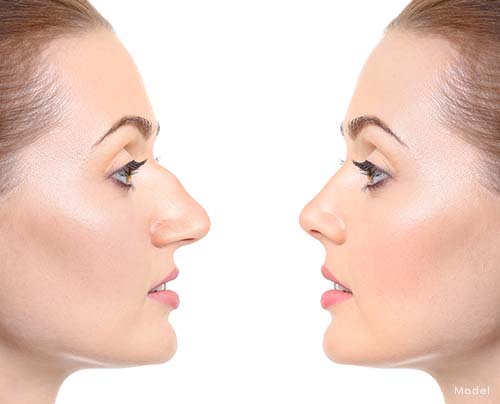Rhinoplasty to Reduce a Nasal Hump

A nasal hump can make your nose look bigger than it is. This can negatively affect your self-image, causing self-esteem issues. With rhinoplasty surgery, Dr. Reichner can reduce the size and appearance of a nasal hump, making it more even with the rest of the bridge of the nose.
What Is a Nasal Hump?
A nasal hump is a large bump on the nasal bridge. It is formed when excessive bone and/or cartilage grows in the nose. If the hump is at the top of the bridge, it will be mostly bone. If the hump is at the lower end of the bridge, it will be mostly cartilage. In many cases, it is a mix of these two types of tissue.
Nasal humps occur due to three reasons:
- Genetics
- A severe injury to the nose
- Excessive force on a baby’s nose during birth
The size of the nasal hump depends on the above factors. While humps are barely visible in some people, in others, they can be quite prominent, especially in profile.
Reducing a Nasal Hump with Rhinoplasty
Nasal surgery, also called rhinoplasty or a nose job, is the most permanent solution to a nasal hump. Before you undergo rhinoplasty, it’s important to consult a board-certified plastic surgeon to find out if it is the right option for you. Dr. Reichner has extensive rhinoplasty experience and will be happy to meet with you for a consultation.
Typically, any person who has a nasal hump and is in good overall health can undergo rhinoplasty for nasal hump reduction. Smokers will need to quit before the date of their procedure to minimize the chance of complications.
During your rhinoplasty consultation, Dr. Reichner will analyze your facial structure and your nasal structure. He will also ask you about your personal aesthetic preferences. Based on this information, Dr. Reichner will design a surgical plan to safely reduce your nasal hump.

The Nasal Hump Reduction Procedure
During rhinoplasty surgery, Dr. Reichner will make small incisions to gain access to the nasal hump. In the case of open rhinoplasty, the incision will be made in the columella (the small fleshy area that separates the nostrils). If it is a closed rhinoplasty, the incisions will be made inside the nostrils.
Dr. Reichner will then address the nasal hump based on its composition and location. Cartilage may be removed, and nasal bone may be altered using either a burr (a tool used for sanding) or an osteotome (a tool used for precise cutting).
Extra support may be provided using a graft. Cartilage grafts are taken from areas like the nasal septum, ear, or rib. They are then shaped and stitched into the nasal architecture to bolster support.
Once all the required changes have been made, incisions will be closed using tiny sutures and then dressed appropriately.
Recovering After Nasal Hump Reduction
Rhinoplasty is major surgery. A degree of swelling, bruising, and tenderness will be present. If there is post-surgical pain, it can be treated using prescribed pain-control medication as directed.
Depending on your pace of recovery, Dr. Reichner may remove the stitches between seven and ten days from the surgery date during a follow-up appointment. Typically, it takes the nose a little over a month to heal. After this, your nasal bridge will look more even and natural.
Schedule Your Consultation
To find out more about undergoing rhinoplasty to reduce a nasal hump, arrange a consultation with Dr. Daniel Reichner. Contact Daniel Reichner Plastic Surgery to schedule your informative appointment.

